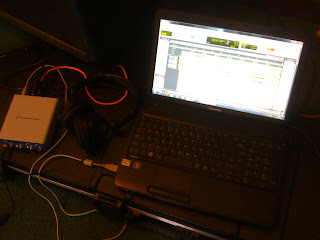For Pre Production, I decided to carry out preliminary and simplified versions of the recording session I intend to carry out for my actual honours project, which will be handed in as test recordings and mixes, which will be used to advise things such as my floor plans, equipment list and the carrying out of my main recording session.
This image shows how the microphone was placed in relation to the amp. The microphone is an SM57 placed around 2-3 inches from the speaker. This was then fed directly into and m-box 2 sound card, plugged into a Macbook running ProTools 8.
The distance which is was placed from the amp is roughly correct, however for the actual recording session, the mic will be placed in more direct relation to one of the 4 speakers within the cabinet. Also, an additional, condensor type microphone (preferably a 414) will also be used to record the amp, though placed slightly further away in order to capture a slightly different tonality from the amp, and generally thicken up the sound of the guitar. This could not be done today due to the capacity of the recording device and also the last minute nature of the booking of this recording session did not leave us enough time to book out microphones.
This image (poorly) shows the D.I. being taken from the bass amp head via an XLR cable (the long red one). This was then fed directly into and m-box 2 sound card, plugged into a Macbook running ProTools 8.
In addition to this, for the actual recording session, I will also be using a dynamic, cardioid microphone with a large diaphragm, such as a shure beta 52a, in order to capture the actual sound heard from the amp within the room. Also, this will give me more options when I come to mix the tracks, and provide a warmer tone produced through the amp which will not be present in the D.I. signal.
This is the fore-mentioned Macbook with ProTools running used to record both Bass and Guitar.
This image shows the basic drum mic set up used to capture the drum sound. This was comprised of a Shure SM58 used as a spot mic on the snare drum, a Shure beta 52a (or similar) placed inside the kick drum and a pencil, condensor type microphone used as an overhead.
For my actual recording session, I will also be placing spot microphones on the rack tom, the floor tom and the high hat stands. I will also be using a stereo pair of condensor microphones as room mics to provide a fuller drum sound, and if possible these microphones will be of a better quality and will have larger diaphragms, allowing them to pick up a fuller range of frequencies.
The fore-mentioned drum mics were ran into this desk, allowing us to set relative levels before taking these signals at the stereo output and running it into another m-box 2 sound card linked to a laptop running pro tools 8.
This image shows the fore-mentioned laptop.
The intention is to bring these 2 separate sessions together on laptop in order to mix them together and produce simple mixes in order to submit as part of post production, in order to justify many of the decisions I will be making in my floor plan, equipment list and microphone set-ups.


















